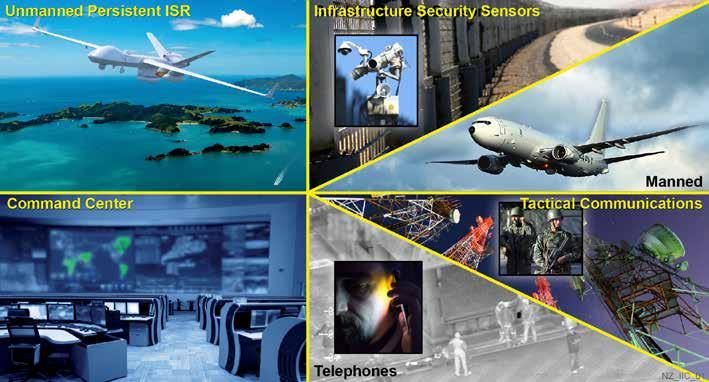
3 minute read
GA-ASI’s new Ops Centre gives RPA operators big picture of ISR
General Atomics Aeronautical Systems, Inc. (GA-ASI) has developed an Operations Data Fusion Centre with a modern open architecture and infrastructure that enables collaborative, reliable, and secure mission execution. With a modular design and focus on open standards, the Ops Centre – also known as the Integrated Intelligence Centre – enables the expansion of capabilities to rapidly incorporate future growth requirements.
The Integrated Intelligence Centre integrates seamlessly with existing C4ISR capabilities – such as sensors data, video and other intelligence products – from Defence and other Government ministries and agencies. The Integrated Intelligence Centre for New Zealand would ingest, process, parse and disseminate ISR video, data and other intelligence products to required users, including tactical to strategic levels, as well as various classification levels.
GA-ASI has the experience in hardware and software design, automation, implementation, sustainment, and operations for Intelligence, Surveillance and Reconnaissance (ISR) to offer an Integrated Intelligence Centre that provides customers with unparalleled ISR operations, situational awareness, and ISR data processing capability – now and into the future,” said GAASI Senior Vice President of Strategic Development Barton Roper.

GA-ASI is known throughout the world for its development of industryleading Remotely Piloted Aircraft (RPA), including the new MQ-9B SkyGuardian, which has been selected by the Australian Defence Force and the UK Royal Air Force, and is being considered by many other countries.
With the addition of the Integrated Intelligence Centre, operators unlock the potential of ISR capabilities installed on GA-ASI’s RPA, as well as manned airborne ISR assets, ground and space-based capabilities. Fully leveraging the Integrated Intelligence Centre will enable users to reduce manpower and create a complete intelligence and operations picture.
Versatile ISR Ops and PED
The heart of the Integrated Intelligence Centre is GA-ASI’s integrated suite of automated mission capabilities, including GA-ASI’s STARE (System for Tactical Archival, Retrieval, and Exploitation) software, MMC (Multi-Mission Controller) software, Metis tasking, collection management, and intelligence sharing software. The combination of these capabilities provides a unified intelligence collection and Processing, Exploitation and Dissemination (PED) capability to efficiently consolidate and allocate ISR assets throughout the entire ISR lifecycle.

The Integrated Intelligence Centre typically consists of a main ops floor, which provides a collaborative environment with multi-functional workstations that facilitates common situational awareness. Other collocated or virtually connected cells address mission support aspects. Modular data centre modules that can be collocated or deployed provide secure, scalable and flexible computing resources and storage to authorized users from any connected workstation. The architecture not only considers the quantifiable aspects of a project, including the number of people and square footage per person, but also the psycho-sociological experience, including the characteristics of the participants, and the cognitive and collaborative demands of their work.
The main ops floor is designed with an operator-centric focus, emphasizing collaboration between operators. By factoring in aspects such as personto-person sightlines, GA-ASI enables important non-verbal communication that is critical to decision-making, such as body language and other visual cues. The enabling technologies integrate remote sites seamlessly through multilevel secure communications, videotele communications (VTC), chat and other collaborative tools.
The front wall of the main ops floor design contains a large unified video wall to provide a common situational view to the entire command centre. The unified video wall displays the STARE and its common operating picture. This includes the location of connected customer assets and platforms, as well as incoming ISR data and other mission critical information. This same information can be disseminated to remote users and viewable on smaller formats such as an iPad.
The combination of these capabilities provides users with the ability to securely and reliably conduct full-spectrum ISR operations that ingests a wide range of inputs. The information supports multiple, disparate end users with flexibility and agility, while limiting manpower requirements.

